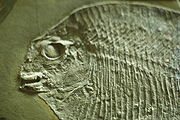
Pycnodus
Encyclopedia
Pycnodus is an extinct genus of ray-finned fish ranging from the Cretaceous
to Eocene
periods. As its name suggests, it is the type genus
of Pycnodontiformes
.
 The known whole fossils of Pycnodus are around 12 centimetres (4.7 in) long, and have a superficial resemblance to angelfish
The known whole fossils of Pycnodus are around 12 centimetres (4.7 in) long, and have a superficial resemblance to angelfish
or butterflyfish
. The animals, as typical of all other pycnodontids, had many knob-like teeth, forming pavements in the jaws with which to break and crush hard food substances, probably mollusks and echinoderms. These teeth are the most common form of fossil.
Pycnodus fossils have been found in present-day India
, , Northern Africa, Belgium
, England
, and Italy
, regions corresponding with the Tethys Ocean
Cretaceous
The Cretaceous , derived from the Latin "creta" , usually abbreviated K for its German translation Kreide , is a geologic period and system from circa to million years ago. In the geologic timescale, the Cretaceous follows the Jurassic period and is followed by the Paleogene period of the...
to Eocene
Eocene
The Eocene Epoch, lasting from about 56 to 34 million years ago , is a major division of the geologic timescale and the second epoch of the Paleogene Period in the Cenozoic Era. The Eocene spans the time from the end of the Palaeocene Epoch to the beginning of the Oligocene Epoch. The start of the...
periods. As its name suggests, it is the type genus
Type genus
In biological classification, a type genus is a representative genus, as with regard to a biological family. The term and concept is used much more often and much more formally in zoology than it is in botany, and the definition is dependent on the nomenclatural Code that applies:* In zoological...
of Pycnodontiformes
Pycnodontiformes
Pycnodontiformes is an extinct order of bony fish. The group evolved during the Late Triassic and disappeared during the Eocene. The group has been found in rock formations in Africa, Asia, Europe, North and South America....
.

Angelfish
Angelfish may refer to:*Several groups of fish:**Freshwater angelfish, tropical cichlids of the genus Pterophyllum**Marine angelfish of the family Pomacanthidae**Angel shark of the family Squatinidae...
or butterflyfish
Butterflyfish
The butterflyfish are a group of conspicuous tropical marine fish of the family Chaetodontidae; the bannerfish and coralfish are also included in this group. Found mostly on the reefs of the Atlantic, Indian and Pacific Oceans, there are approximately 120 species in 10 genera...
. The animals, as typical of all other pycnodontids, had many knob-like teeth, forming pavements in the jaws with which to break and crush hard food substances, probably mollusks and echinoderms. These teeth are the most common form of fossil.
Pycnodus fossils have been found in present-day India
India
India , officially the Republic of India , is a country in South Asia. It is the seventh-largest country by geographical area, the second-most populous country with over 1.2 billion people, and the most populous democracy in the world...
, , Northern Africa, Belgium
Belgium
Belgium , officially the Kingdom of Belgium, is a federal state in Western Europe. It is a founding member of the European Union and hosts the EU's headquarters, and those of several other major international organisations such as NATO.Belgium is also a member of, or affiliated to, many...
, England
England
England is a country that is part of the United Kingdom. It shares land borders with Scotland to the north and Wales to the west; the Irish Sea is to the north west, the Celtic Sea to the south west, with the North Sea to the east and the English Channel to the south separating it from continental...
, and Italy
Italy
Italy , officially the Italian Republic languages]] under the European Charter for Regional or Minority Languages. In each of these, Italy's official name is as follows:;;;;;;;;), is a unitary parliamentary republic in South-Central Europe. To the north it borders France, Switzerland, Austria and...
, regions corresponding with the Tethys Ocean
Tethys Ocean
The Tethys Ocean was an ocean that existed between the continents of Gondwana and Laurasia during the Mesozoic era before the opening of the Indian Ocean.-Modern theory:...

